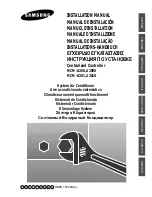
8
GENERAL INFORMATION
The Dual Fuel iHybrid™ heat pump has been designed
and tested for capacity and efficiency in accordance with
A.R.I. Standards. This unit will provide many years of safe
and dependable comfort, providing it is properly installed
and maintained. This heat pump is designed only for
outdoor installations. With regular maintenance, this unit
will operate satisfactorily year after year. Abuse, improper
use, and/or improper maintenance can shorten the life of
the appliance and create unsafe hazards.
To achieve optimum performance and minimize equipment
failure, it is recommended that periodic maintenance be
performed on this unit. The ability to properly perform
maintenance on this equipment requires certain tools
and mechanical skills.
Pre-Installation Check
√
Before you install this unit, the cooling load of the area
to be conditioned must be calculated and a system of
the proper capacity selected. It is recommended that
the area to be conditioned be completely insulated and
vapor sealed.
√
Check the electrical supply and verify the power supply
is adequate for unit operation. If there is any question
concerning the power supply, contact the local power
company.
√
All units are securely packed at the time of shipment and
upon arrival should be carefully inspected for damage
prior to installing the equipment at the job site. Verify
coil fins are straight. If necessary, comb fins to remove
flattened or bent fins. Claims for damage (apparent or
concealed) should be filed immediately with the carrier.
√
Please consult your dealer for maintenance information
and availability of maintenance contracts. Please read
all instructions before installing the unit.
Locating the Heat Pump
• Survey the job site to determine the best location for
mounting the outdoor unit.
• Choose an appropriate location that minimizes the
length of the supply and return air ducts.
• Overhead obstructions, poorly ventilated areas, and
areas subject to accumulation of debris should be
avoided.
• Sufficient clearance for unobstructed airflow through
the outdoor coil must be maintained in order to achieve
rated performance. See Figure 2 for minimum clearance
requirements.
• Consideration should also be given to availability of
electric power, service access, noise, and shade.
• A clearance of at least 36 inches from the blower access
panel and from the louvered control access panel is
recommended for servicing and maintenance.
Where
accessibility to combustibles clearances are greater
than minimum clearances, accessibility clearances
must take preference.
Field Connections for Electrical Power Supply
• All wiring must comply with current provisions of the
National Electrical Code (ANSI/NFPA 70) and with
applicable local codes having jurisdiction.
• The minimum size of electrical conductors and circuit
protection must be in compliance with information listed
on the outdoor unit data label.
• Electrical power supplied to the unit must be adequate
for proper operation of the equipment. The system
must be wired and provided with circuit protection in
accordance with local building codes.
Heating Load
This unit should be sized to provide the design heating
load requirement. Heating load estimates can be made
using approved methods available from Air Conditioning
Contractors of America (Manual J); American Society of
Heating, Refrigerating, and Air Conditioning Engineers;
or other approved engineering methods. For installations
above 2,000 ft., the unit should have a sea level input
rating large enough that it will meet the heating load after
deration for altitude.
Combustion Air Requirements
WARNING:
Using installation methods other than those
described in the following sections must comply
with the National Fuel Gas Code and all applicable
local codes for providing sufficient combustion
air to the furnace.
Provisions must be made during the installation of this
unit that provide an adequate supply of air for combustion.
• Instructions for determining the adequacy of an
installation can be found in the current revision of the
NFGC (ANSI Z223.1 / NFPA54).
Consult local codes
for special requirements
. These requirements are for
US installations as found in the NFGC.
• The requirements in Canada (B149.1) are structured
differently. Consult with B149.1 and local code officials
for Canadian installations.
Minimum Required
Clearances to Combustibles
36"
36"
36"
TOP OF UNIT
TO
BE
UNOBSTR
UCTED
See Note 1
See Note 2
NOTE 1:
6” When coil is present on duct side.
NOTE 2:
1” When no coil is present on duct side.
Figure 2. Clearance Requirements









































